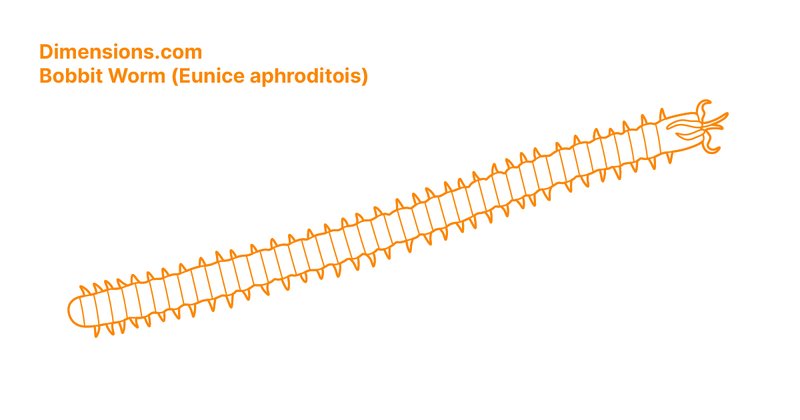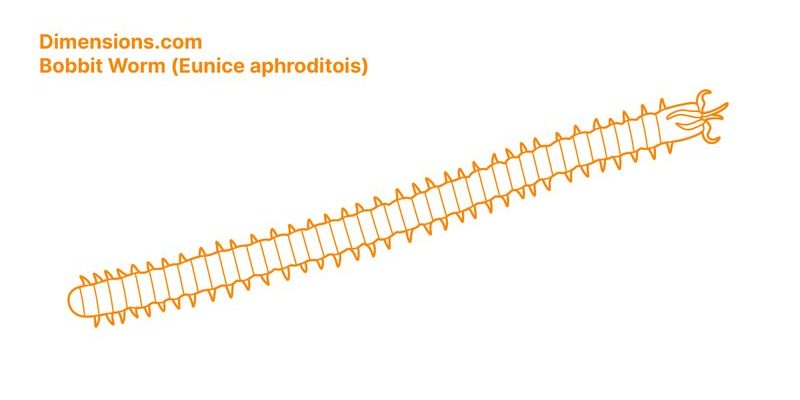
Imagine you’re at a buffet, but instead of food, there are small fish and invertebrates swimming casually above. Just beneath the surface, a Bobbit worm is lying in wait, ready to snatch a meal. The way they’re built—specifically their long, segmented bodies and specialized appendages—equips them to catch dinner with impressive speed. Let’s dig into the anatomy of the Bobbit worm and see how its design contributes to its ambush tactics.
What is a Bobbit Worm?
Before we dive into their anatomy, it’s crucial to know what a Bobbit worm actually is. These worms belong to the family Eunicidae and can grow up to 10 feet long, though most are a bit shorter. They’re often found in tropical and subtropical waters, mostly hiding in the sandy or muddy seabed. Their scientific name is *Eunice aphroditois*.
Bobbit worms are known for their distinct, brightly colored bodies, which can come in various shades like green, red, and brown. This striking appearance might make them look harmless, but that’s far from the truth. They have powerful jaws and an ambush strategy that keeps them well-fed and respected in their ecosystem.
Segmented Body Structure
One of the most defining features of the Bobbit worm is its segmented body. These segments, which can number in the dozens, allow the worm to move gracefully through the sand or mud. Each segment is flexible and helps the worm coil and extend itself without much effort.
Here’s the thing: the segmentation contributes not just to mobility but also to growth. As the worm matures, it can add more segments to its body, allowing it to lengthen without losing its agility. Think of it like adding links to a chain; more links mean more length and flexibility, but the chain still moves smoothly.
Moreover, the segments are often adorned with **parapodia**, which are fleshy, paddle-like structures on each segment. These help the Bobbit worm swim or burrow more efficiently, expanding its range of movement in its underwater environment.
The Jaw Structure of a Bobbit Worm
Now, let’s talk about why Bobbit worms are known as fierce predators. Their **jaws** are a critical feature of their anatomy. Each Bobbit worm has a pair of powerful jaws that are distinctly shaped and can snap shut with lightning speed. When potential prey approaches, the worm can launch its jaws to grab the unsuspecting fish or crustacean.
You might be wondering how strong these jaws are. In fact, they can deliver a bite that’s strong enough to slice through soft-bodied organisms. It’s as if they’re equipped with a pair of scissors rather than just jaws. This ambush design is where their predatory success stems from; they can remain hidden, waiting silently for the right moment to strike.
Interestingly, their jaws are often lined with sharp teeth, enhancing their ability to capture and hold onto slippery prey. This isn’t just for show—these adaptations make them skilled hunters in their underwater habitats.
Camouflage Techniques
Camouflage is another essential part of a Bobbit worm’s ambush strategy. Their coloration often matches the substrate of their environment, blending in seamlessly with sand, rocks, or mud. This natural disguise allows them to hide from both prey and potential threats.
When a Bobbit worm is lying in wait, it resembles a piece of the seafloor more than a living creature. This gives them the element of surprise. Imagine playing hide-and-seek; the best hiding spots are always those that blend into the background. For the Bobbit worm, staying hidden is key to both hunting and safety.
Additionally, some Bobbit worms can even create a small burrow that offers further concealment. They dig into the substrate using their parapodia and can retract back into their hideouts if they feel threatened. This dual-purpose functionality makes their camouflage strategy extraordinarily effective.
Feeding Habits and Digestion
Bobbit worms are carnivorous, and their feeding strategies are directly linked to their anatomy. Once they capture prey with their jaws, they pull it back toward their bodies. This action is quick and efficient, showcasing their ambush design to perfection.
After catching their meal, the digestive process kicks in. The worm can consume its prey whole, thanks to its stretchy body and strong jaws. Inside, specialized digestive enzymes break down the food, allowing the Bobbit worm to absorb nutrients. It’s a system designed for efficiency and effectiveness.
You might find it interesting that Bobbit worms can go for long periods without eating, thanks to their ability to metabolize stored energy. This means they can survive even when prey is scarce, a useful adaptation in their changing underwater environment.
Reproduction and Lifespan
The reproductive habits of Bobbit worms are as intriguing as their predation techniques. They can reproduce sexually, with males and females releasing gametes into the water. After fertilization, the larvae drift in the ocean before settling down and maturing into adult worms.
One of the fascinating aspects is the lifespan of Bobbit worms. They can live for many years, some estimates say up to 20 years or more! This long life gives them plenty of time to master their ambush techniques and adapt to environmental changes.
Interestingly, some species of Bobbit worms can regenerate lost segments or even parts of their jaws. This regeneration ability adds to their resilience, allowing them to thrive despite challenges or injuries incurred during hunting or predator interactions.
Understanding Bobbit worm anatomy reveals a world of remarkable adaptations that make them lethal predators. Their **segmented bodies**, powerful jaws, and clever camouflage come together to create a total ambush design that’s hard to beat. These fascinating creatures remind us of the incredible diversity and complexity of life beneath the waves.
Next time you think about marine life, consider the Bobbit worm—a creature that’s both beautiful and fearsome. Their design is a perfect example of evolution at work; they’ve adapted to not just survive, but thrive in their underwater environments. So, whether you’re exploring tidal pools or just curious about ocean life, the Bobbit worm is a captivating subject worth knowing!

